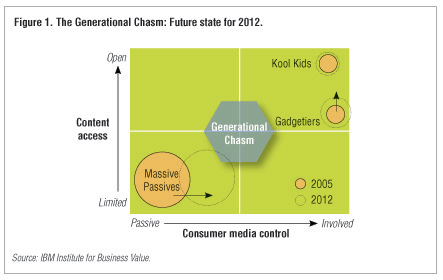
BY 2012, THE TV viewing audience will consist mainly of two types of viewers, according to IBM Business Consulting.
One group will be the traditional, passive set, content to vege on their couches and watch whatever comes on.
The other group is, of course, the “I want everything I want when I want it” on-demand group.
“Today, audiences are becoming increasingly fragmented, splicing their time among myriad media choices, channels and platforms,” says the report.
“For the last few decades, consumers have migrated to more specialized, niche content via cable and multichannel offerings. Now, with the growing availability of on demand, self-programming and search features, some experiences are moving beyond niche to individualized viewing. With increasing competition from convergence players in TV, telecommunications and the Internet, the industry is confronting unparalleled complexity, dynamic change and pressure to innovate.”
The future is about 2012, says IBM, from both a demand and supply perspective. The company conducted extensive industry interviews across the value chain and commissioned Economist Intelligence Unit (EIU) primary research in the U.S., Europe and Asia.
The analysis indicates that market evolution hinges on two key market drivers: openness of access channels and levels of consumer involvement with media, says the report.
For the next five to seven years, there will be change on both fronts – but not uniformly. The industry instead will be “stamped by consumer bimodality, a coexistence of two types of users with disparate channel requirements,” says the report – a turn of phrase found only in reports like these.
While one consumer segment remains passive in the living room, the other will force radical change in business models in a search for anytime, anywhere content through multiple channels.
“The tech- and fashion-forward consumer segment will lead us to a world of platform-agnostic content, fluid mobility of media experiences, individualized pricing schemes and an end to the traditional concept of release windows,” it continues.
Figure 1 (right) illustrates the behavioral differences that will lead to the "Generational Chasm" between the passive mass audience ("Massive Passives") and leading-edge users (divided into two sub-groups: "Gadgetiers" and "Kool Kids").
This is the beginning of "the end of television as we know it" and the future will only favor those who prepare today, says the report.
IBM offers six executive recommendations to get started:
Segment: Invest in divergent strategies and supply chains for bimodal consumer types. Identify, develop and continually refine data-driven user profiles in order to optimize product and service development, distribution, marketing messaging, and service migration. Tailor content, advertising, pricing and reach dynamically.
Innovate: Innovate business and pricing models by creating – not resisting – wider consumer choice with windows, bundles, pricing and distribution. Take risks today to avoid losing position long-term.
Experiment: Develop, trial, refine, roll-out. Repeat. Conduct ongoing market experiments alone and with partners to study "real life" consumer preferences. Invest in new measurement systems and metrics for the on demand world of tomorrow.
Mobilize: Create seamless content mobility for users that require on-the-go experiences. Ensure easy synchronization across devices and without user intervention.
Open: Drive open content delivery platforms to optimize content and revenue exploitation, and to create optimum business flexibility and network cost-efficiency. Position open capabilities to bolster digital content protection with consumer flexibility, and for plug-and-play business upgrades necessary in the fast-changing marketplace.
Re-organize: Assess business assets against future requirements. Identify core competencies needed for future competitive advantage. Isolate non-core business components for outsourcing or partnership. From an external perspective, reconfigure business to exploit market and financial levers to buy, build or team to future competitiveness.




